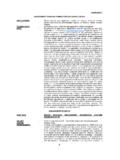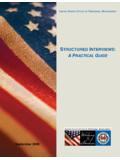Transcription of Interviewing for APS Jobs - Selection Criteria …
1 Interviewing for APS jobs Page 1 of 27. Interviewing for APS jobs Introduction About the ILS. The Integrated Leadership System (ILS) is an outgrowth of the Senior Executive Leadership Capability (SELC) Framework. SELC was established in 1999 to help those seeking executive leadership positions within the Australian Public Service (APS). ILS has taken these standards and expanded them to include all leadership positions. The series of tools and assessments provided by the ILS supports both individuals and agencies The ILS has provided agencies with a standardised way to assess applicants. This method ensures that all applicants are treated similarly and that their suitability to the requirements of the job are adequately covered. Interviewing for APS jobs A strong application will lead to an interview. The elements of the application include a cover letter, cover sheet, CV or resume, a statement which addresses the Selection Criteria , and referees with contact information.
2 Interviews are conducted by a Selection team made up of two or three APS employees, usually including the supervisor of the job. When one agency is recruiting for multiple positions, the interview is often conducted in an assessment centre. Applicants may be asked to do group exercises, job simulations, or role-playing. Five main areas of Selection Criteria based on core capabilities are stressed in the interview. They are: Supports strategic direction Achieves results Supports productive working relationships Displays personal drive and integrity Communicates with influence Questions are asked based on these Criteria . They include behavioural based questions, hypothetical situation questions, and, in some cases, work sample tests, presentations, or psychometric testing, which may include aptitude and/or personality tests. Behavioural based questions are those which ask about how a situation was handled in the past. This type of questions helps the panel to predict how a similar situation would be handled in the future.
3 Hypothetical situation questions how the applicant might respond to a given situation. During the interview, one should not be afraid to ask for clarification on a question, or to take a moment to compose a response. Most everyone is somewhat nervous in a job interview. Preparation is very helpful in overcoming the possible effects of anxiety. This guidebook is intended to help applicants understand how to answer the interview questions posed by the review panel. All possible questions have been included and sample answers have been provided. Page 2 of 27. Interviewing for APS jobs Selection Criterion: Supports Strategic Direction Question: Tell me about a time when you were involved in planning a project, how did you go about it, what factors did you consider in your planning, and what was the outcome? For this question, the panel are seeking to learn about your approach to supporting a shared purpose and direction and strategic thinking and focus.
4 Goal setting, planning ahead, and an understanding of objective and long-term implications of the work are some of the factors that the panel will look for. To answer the question, select a project that is relevant to the position for which you are applying, or which used skills similar to those that will be prominent in the new position. Describe the conditions or context for which the project was needed. Next, explain what your own responsibility or duty was regarding the task; for example, if you were the project leader, or a subject matter expert. Then, describe specifically what you did and how it was done. Finally, talk about the results This stepwise approach to answering a question is known as the STAR method, and it can be used to prepare your answer to any question in this guidebook. The acronym stands for Situation, Task, Actions, and Results. Sample Answer: Management asked our group to revise the operating procedure documents.
5 There were several hundred documents and we wanted to rewrite them so that they each followed the same format. I was chosen to be the project leader. As a group, we determined what the format should be and created a template. The documents were divided into groups and each team member was responsible to complete a certain number of them. I set deadlines and check-in points, and performed a final review of each document before it was submitted to our controlled documents system. We completed the project on time and were successful in creating procedures that were easier for our technicians to use.. Question: Give me an example when you were met with an obstacle that was preventing you from meeting an objective/deadline, how did you overcome it and what was the result? For this question, the panel are interested in your judgement, intelligence, and commonsense, as well as your ability to think strategically and utilise information.
6 Using the STAR method, begin with the context of the situation in which the obstacle arose and your own responsibility at the time. Proceed to describe in detail what the obstacle was, how it impacted the deadline or objective, and how you dealt with the situation. As always, choose a situation that is most relevant to the job for which you are applying. Sample Answer: I was preparing an informational letter that was to be distributed to the public. I had contacted a vendor for some data that we needed to include in the letter. However, they did not get the information back to me in time, even though I had stressed the deadline, and despite repeated attempts at contact. I had to go to my supervisor and request an extension. In the end, I found another person at the vendor who was able to fax the data to me and I was able to meet the deadline after all.. Page 3 of 27. Interviewing for APS jobs Question: Give me an example where you have used your initiative or critical thinking to make improvements to work practices or processes?
7 With this question, the panel desires to learn about your ability to harness information and opportunities to support the shared purpose of the agency or department, as well as your strategic thinking. They are looking for candidates who are alert to opportunities for improvement and will take the initiative to pursue them. In your answer, give a little bit of background about the work practice or process you are talking about. Then describe your improvement and in particular, the thought process that brought you there. Include any ways in which you used information from other sources. Be sure to include how the improvement benefited the business. Sample Answer: I noticed that the supervisors were complaining a lot about how long the approval process was for shipping requests. They felt that it was impacting our turnaround times. I started to think about our other approvals and how they were different. For example, the approvals for work orders went through quickly.
8 The main difference was that the shipping requests needed to be done in a specific order the initiator, then the supervisor, then finance, and so on but the work orders just needed the full complement of approvals: they could be obtained in any sequence. When I mentioned it, management was afraid that if requests didn't follow the sequence, more delays would occur if one of the signers rejected the request. So we came up with a compromise that the requests would go to the most important signatories first, but after that they could be routed in any order until all the required signatures had been obtained. This did end up improving shipping turnarounds.. Question: Tell me about a time when your attention to detail has led to an improved outcome. The panel wishes to learn more about your support of shared purpose and your strategic focus. They want to see that you are dedicated to getting things done properly and that you are attentive to business needs and can see the big picture.
9 Consider a time when you identified an issue, or devised an improvement, that really impacted productivity or the bottom line. Describe the conditions under which you made the discovery, and detail your thought process as much as is relevant. Finally, make clear how an adverse effect on the business was avoided or diminished. Sample Answer: All of our documents were reviewed for accuracy by two people before being sent to the printer. I was preparing a document for the printer when I noticed that there was only one signature at the bottom. There was no requirement for me to check the signatures, but I was in the habit of doing so. It turned out that the second reviewer had requested a revision to be made, but the initiator had forgotten about that and sent it on to me instead. If the document had gone to the printer as it was, it would have meant wasted time and money to redo the letter.. Page 4 of 27. Interviewing for APS jobs Question: Tell us about a time when you applied an innovative approach to a task or situation to improve the efficiency of your team or workplace.
10 What steps did you take to get the idea accepted and implemented? Here, the panel wishes to assess your strategic thinking, your innovative thought process, and your dedication to inspiring a sense of purpose and direction in your department. They will also be looking at your ability to align goals of the organisation with operational tasks. Establish the context of the situation or process that you are talking about, and explain why you felt that a new approach was needed. Go through each step you took when putting forth your idea. Especially include any stage at which you met with resistance, and describe how you responded. Sample Answer: There were times that more than one person needed to use the testing equipment, and sharing the equipment was not possible. That resulted in a lot of idle time for the technician who was waiting, and management wasn't happy. It occurred to me that if we had more flexible deadlines and could choose which project to work on, we could reduce the amount of lost time.






